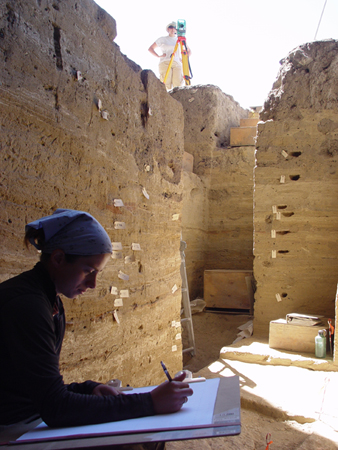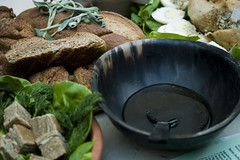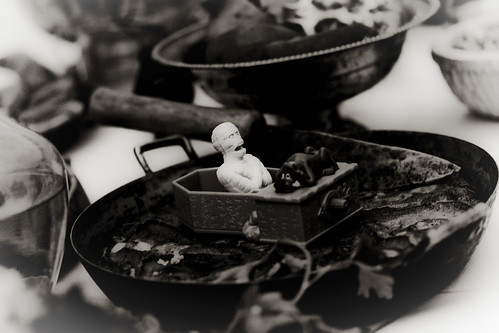 Thinking of Lucy strolling around the east African landscape in search of food, we can nowpicture her looking for meat with a stone tool in hand.
Thinking of Lucy strolling around the east African landscape in search of food, we can nowpicture her looking for meat with a stone tool in hand.
Bones foundin Ethiopia, push back the earliest known stone tool use and meat consumption by almost one million years and provide the first evidence that these behaviours can be attributed to Lucy’s species.
Aninternational team of researchers has discovered evidence our ancestors were using stone tools and ate the nutricious meat and marrow of large mammals 1 million years earlier than previously documented.
While working in the Afar region of Ethiopia, the Dikika Research Project (DRP) found bones bearing evidence of stone tool use; cut marks made while carving meat off the bone and percussion marks created while breaking the bones open to extract marrow.
The bone fragments – dated to roughly 3.4 millionyearsago- also provide the first record of stone tool use and meat consumption by the Australopithecus afarensis. Until now onlytracesof stone tool use by members of the genus Homo were found.
This discovery dramatically shifts the known timeframe of a game-changing behaviour for our ancestors, says paleoanthropologist Dr Zeresenay Alemseged. Tool use fundamentally altered the way our earliest ancestors interacted with nature, allowing them to eat new types of food and exploit new territories. It also led to tool making – the precursor to such advanced technologies as aeroplanes, MRI machines, and iPhones.
With stone tools in hand to quickly pull off flesh and break open bones; animal carcasses would have become a more attractive source for food. This type of behaviour sent us down a path that later would lead to two of the defining features of our species – carnivory and tool manufacture and use.
Although the butchered bones may not look like particularly noteworthy fossils to the lay person, Alemseged can hardly contain his excitement when he describes them. “This find will definitely force us to revise our text books on human evolution, since it pushes the evidence for tool use and meat eating in our family back by nearly a million years,” he explains. “These developments had a huge impact on the story of humanity.”
The team’s research,reported in the August 12th issue of Nature, shows that the marks were created before the bones fossilized. This means recent damage can be eliminated as cause of the cut-marks.
One cut mark even contained a tiny, embedded piece of rock left behind during the meat cleaving.
“Most of the marks have features that indicate without doubt that they were inflicted by stone tools,” explains Dr. Curtis Marean from the Arizona State University, who performed the mark identifications. “And the range of actions includes cutting and scraping for the removal of flesh, and percussion on the femur for breaking it to access marrow.”
Cutting-edge technology
Until now, the oldest known evidence of butchering animals with stone tools camefrom Bouri, Ethiopia, where several cut-marked bones date to about 2.5 million years ago. The oldest known stone tools, dated to between 2.6 and 2.5 million years ago, were discovered at Gona, Ethiopia and most scientists believe the stone instruments were made and used only by early members of the genus Homo.
The new cut-marked fossil animal bones from Dikika have been dated to approxiamately 3.4 million years ago. They were founda few hundred meters away from where Alemseged’s team previously discovered ‘Selam’, a young A. afarensis girl who lived about 3.3 million years ago.
 Two parallel cut marks made by stone tools cutting into tissues on the rib of a cow-sized or larger hoofed animal. – Image copyright the Dikiki Research Project
Two parallel cut marks made by stone tools cutting into tissues on the rib of a cow-sized or larger hoofed animal. – Image copyright the Dikiki Research Project
 A cut mark made by a stone tool cutting into flesh on the upper leg bone (femur) of goat-sized young bovid. – Image copyright the Dikiki Research Project
A cut mark made by a stone tool cutting into flesh on the upper leg bone (femur) of goat-sized young bovid. – Image copyright the Dikiki Research Project
The location and age of thebone fragments clearly indicate that members of the Australopithecus afarensis species made the cut marks.
The only hominin species we have in this part of Africa at this time period is A. afarensis, and so we think this species inflicted these cut marks on the bones we discovered, notes Alemseged.
Dating the bones
To determine the age of the bones, project geologist Dr. Jonathan Wynn relied on a very well documented and dated set of tuffs (volcanic deposits).
These same tuffs were previously used to determine Selam’s age and are known from nearby Hadar, where Lucy was found.
The new find site is located in a drainage that contains only deposits older than a tuff securely dated to 3.24 million years ago. Below the find site is a tuff dated to 3.42 million years ago.
Because the cut-marked bones are much closer to the lower tuff, the bones’ age is most likely 3.4 million years old.
Large beasts on the menu
Both of thebones came from large mammals.
“The bones come from 2 animals, one (a femur) the size of a goat and the other (a rib) at least the size of a cow,” notesMarean. “Our closest living relatives, the chimps and bonobos, don’t hunt or scavenge animals this size, so this suggests that the Dikika australopithecines had already begun to engage in hunting or scavenging larger mammals.”
This placed them in risky competition with other carnivores, which would likely have required them to engage in an unprecedented level of teamwork.

A stone tool industry at Dikika?
While it is clear that the australopithecines at Dikika were using sharp-edged stones to carve meat from bones, it is impossible to tell from the marks alone whether they were making their tools or simply finding and using naturally sharp rocks.
So far, the research team has not found evidence of stone tool manufacture at Dikika from this early time period.
It is possible the Dikika residents were simply opportunistic about finding and using naturally occurring sharp-edged stones. However, there is another potential explanation.
“For the most part, the only stones we see coming from these ancient sediments at Dikika are pebbles too small for making tools,” says Dr. Shannon McPherron, archaeologist with the DRP and research scientist at the Max Planck Institute for Evolutionary Anthropology in Leipzig. “The hominins at this site probably carried their stone tools with them from better raw material sources elsewhere.
The team plans to return to Dikika and see if they can find these locations and evidence that at this early date hominins were actually making, not just using, stone tools.
Evolutionary ideas
While many questions remain about the history of tool use and tool making and about the timing and motivation of dietary changes among human ancestors, this discovery adds a rich new chapter to the story.
“Now, when we imagine Lucy walking around the east African landscape looking for food, we can for the first time imagine her with a stone tool in hand and looking for meat,” says Dr. McPherron.
“With stone tools in hand to quickly pull off flesh and break open bones; animal carcasses would have become a more attractive source for food. This type of behaviour sent us down a path that later would lead to two of the defining features of our species – carnivory and tool manufacture and use.”
 Almost 10,000 years ago, in Utahs Escalante Valley, a new recipe was added to the prehistoric cookbook: mush cooked from the flour of milled sage brush seeds.In those times,what else would the early chefs put on your plate..err… rock?
Almost 10,000 years ago, in Utahs Escalante Valley, a new recipe was added to the prehistoric cookbook: mush cooked from the flour of milled sage brush seeds.In those times,what else would the early chefs put on your plate..err… rock? Thinking of Lucy strolling around the east African landscape in search of food, we can nowpicture her looking for meat with a stone tool in hand.
Thinking of Lucy strolling around the east African landscape in search of food, we can nowpicture her looking for meat with a stone tool in hand.  Two parallel cut marks made by stone tools cutting into tissues on the rib of a cow-sized or larger hoofed animal. –
Two parallel cut marks made by stone tools cutting into tissues on the rib of a cow-sized or larger hoofed animal. –  A cut mark made by a stone tool cutting into flesh on the upper leg bone (femur) of goat-sized young bovid.
A cut mark made by a stone tool cutting into flesh on the upper leg bone (femur) of goat-sized young bovid.



